Text

Free Courses
The ones in bold are free but, they also offer some functionalities behind a paywall.
Code.org
FreeCodeCamp
Harvard Courses
W3 Schools
Geeks For Geeks
Replit
The Odin Project
Raspberry Pi Projects
Google’s Web Fundamentals
TeachYourselfCS
MIT Open CourseWare
Crash Course
SoloLearn
JetBrains Academy
CodeFirstGirls MOOCS
PBS
Boolean Girl
Dev Launchers
566 notes
·
View notes
Photo
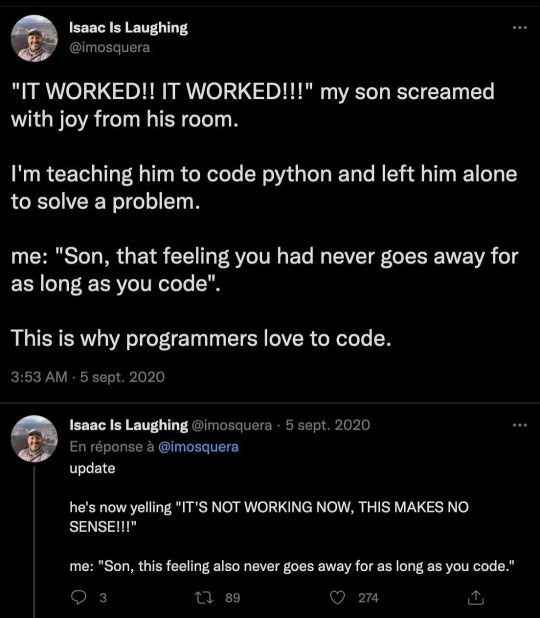
Mundane events for a programmer.
23K notes
·
View notes
Text
I coded so much this weekend I actually injured my neck from sitting in the same position on the sofa for so long without moving
Don't be like me, kids
#codeblr#csblr#stemblr#studyblr#adult studyblr#yes i still exist#chiseling away#i do realize my last personal post on this blog was uh... two years ago#pre-pandemic and everything#but every time i come back to coding i'm better at it and enjoy it more :')
41 notes
·
View notes
Text

Perhaps best known as a video game developer, Corinne Yu is an accomplished computer programmer, technological researcher, aerospace software engineer and businesswoman. Yu studied electrical engineering at California State Polytechnic University, Pomona while working full-time as a programmer, and eventually pursued a career in video game development, working on early projects such as the King’s Quest series, and developing and selling her own custom 3D engines. It was during her early years in game development that she became the unsung legend who wrote the base code for Quake 2, which has continued to influence video game graphics engines to this very day. Throughout her storied career, Yu has gone on to develop pioneering modifications of Epic’s Unreal tech with shadow and lighting effects that again are still used as a base for game developers today. Her most well-published achievement (despite having prior written the base code for motherfucking Quake 2) is being hired by Microsoft as their principle engine architect for a then unknown studio known as 343 Industries, for which Yu played a central role to develop the current graphics technology used in the Halo series, personally programming their lighting and facial animation software, the latter of which was applied for a software patent. Corinne later left Microsoft to work for Amazon, helping develop automation software for their Prime Air program. Yu has also worked for Gearbox as a programmer for their Brothers in Arms and Borderlands series, and on coding with Naughty Dog on various Playstation 4 properties. Yu was later hired as Vice President of Engineering by General Motors to spearhead their research into fully automated vehicle software. Yu has also, of course, worked for Rockwell International as a programmer for the Space Shuttle program, and has created and operated LINAC (medical linear accelerator) software experiments at Brookhaven National Laboratory. Though awarded Best In Engineering two years in a row at GDC, and being the only coder listed by Kotaku as one of gaming’s top 10 most influential women, Yu seems to be more interested in work than in the spotlight, and aside from a handful of interviews appears to most often keep to herself. Yu is married and has a daughter, continuing to work in software development today.
99 notes
·
View notes
Text
If you’re looking to practice and grow your CSS skills, here are some challenges that you can participate in to grow your skills.
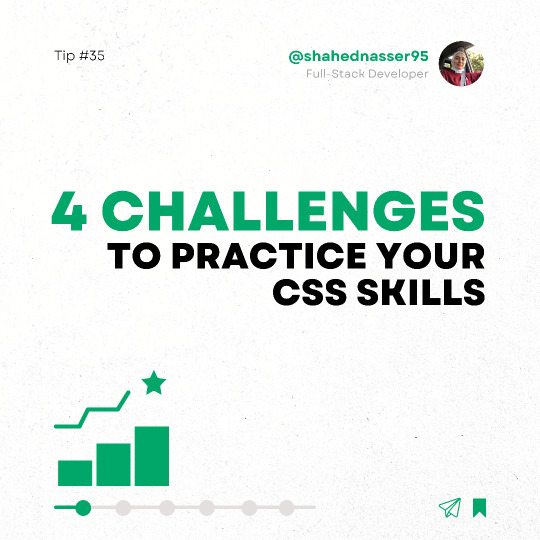
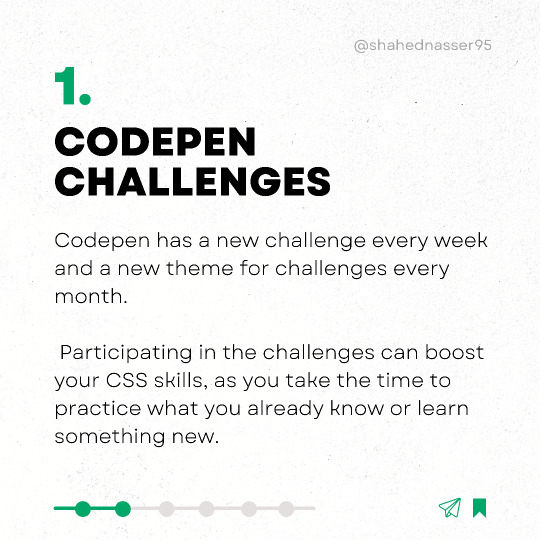
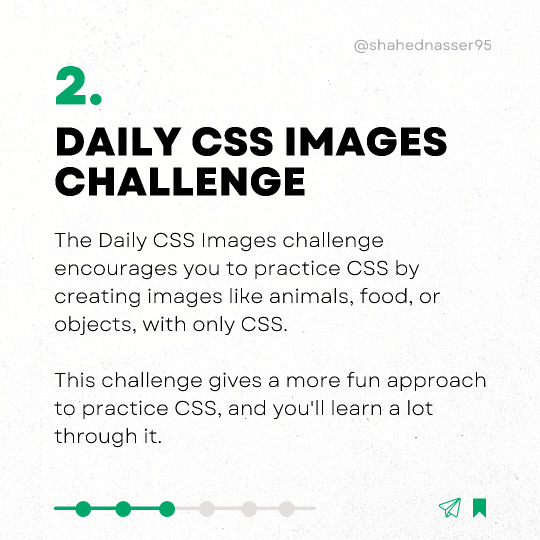

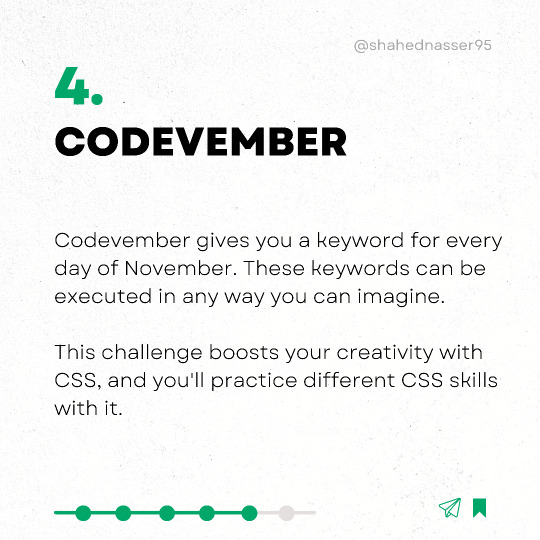
181 notes
·
View notes
Link
For this purpose, I’d like to suggest you build a book directory, where you would need to create endpoints, using the four most basic methods: GET, POST, PUT and DELETE. blog.duomly.com/node-js-project-ideas-for-beginners/
20 notes
·
View notes
Text
So there are a bunch of asks in my inbox wondering what certifications would be good to work in tech and here’s the deal, I’m SonicWall Certified and for, like, a month in 2014 or something like that I was Windows Certified to manage 8.1 systems but here’s a direct quote from my boss talking to our techs that I think explains pretty clearly why I have ZERO idea what kind of certs you might want to look into:
“I guess you have not met me yet, I don’t believe in taking time off during work hours and getting certified unless it is something we absolutely need and cannot do the job without the training.”
For context that was a response to our operations manager trying to get approval for 2 days of in-office, remote training and $350 *TOTAL* for our five techs to get certified on a tool that we’re subscribed to for $200 a month that none of the techs know how to use and that the boss is continually berating the techs for not using.
His solution, instead of training, is to have the Operations Manager take screencap videos of himself using the tool and narrating his use for the techs to watch and learn when they’re off the clock because “working hours are for billing” and “salary means you don’t have off hours.”
This is a bit of a problem because the Operations Manager is already working something like 12 hours a day and doesn’t have time to do his actual job, let alone record training videos.
So, like, Gary is really awful to me but it’s kind of comforting that he’s actually really awful to everyone.
323 notes
·
View notes
Text
when struggling to code something relatively easy, there are but two possibilities
1. the solution is simple and you are an idiot for not seeing it
or
2. there’s no way the solution is that simple and you’re an idiot for thinking it is
in conclusion, you are an idiot either way 😌
52 notes
·
View notes
Text
hot take on hacking, if you’re genuinely good at it, you wouldn’t go around telling people you are
39 notes
·
View notes
Photo
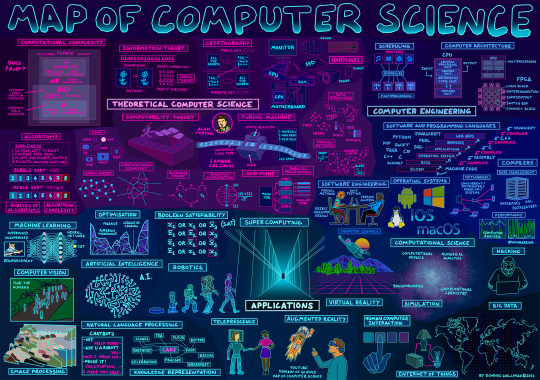
Map of Computer Science by Dominic Walliman
Computer science is the subject that studies what computers can do and investigates the best ways you can solve the problems of the world with them. It is a huge field overlapping pure mathematics, engineering and many other scientific disciplines. Link to the video.
He should have mentioned interpreters alongside compilers and computer security alongside hacking but it is still pretty awesome.
96 notes
·
View notes
Text
Advent of Code
Because I am the most distractible student ever, I started Advent of Code instead of progressing with any of my (many) other coding projects... >_<
It’s so fun though! I got to it a couple of days late, so I did Day 1 and half of Day 2 in one go. It’s bedtime now, so I’ll have to finish Day 2 tomorrow.
5 notes
·
View notes
Text
back and forth, backend frontend
I much prefer backend and would love to spend my career doing primarily that. But I can also appreciate the power and independence of being a full-stack developer, despite the fact that HTML and CSS are not exactly my favorite thing.
So, since I’ve been pretty exclusively focusing on backend lately, I decided to take a quick break to freshen up my rusty frontend skills. How? By returning to The Odin Project, something I hadn’t looked at in years.
TOP was really useful to me back in the day – I finished several of the milestone projects, including a complete visual imitation of the Google homepage that I was pretty proud of, and a functional (if somewhat basic) etch-a-sketch application. But I never got very far through it, because I became distracted by other challenges/projects/resources. (Story of my life.)
So now I’ve decided to return to it and work through as much of the curriculum as I have patience for. I’ve set myself this very unimpressive goal (as opposed to “I’m going to finish it completely!”) because TOP is obsessed with Ruby, a language I have no interest in learning at present. Even though the curriculum’s been revamped to have three possible study ���tracks” – Full Stack JavaScript, Full Stack Ruby on Rails, and Front End Only – the JS track still manages to shoehorn Ruby in, for some inexplicable reason.
In any case, I chose the JS track, which is divided into five units:
1. Web Development 101
2. JavaScript
3. HTML and CSS
4. NodeJS
5. Getting Hired
I’m currently two-thirds of the way through the first unit, and I must say it’s great to get a refresher of stuff I hadn’t touched in a while. Tonight I completed the final “JavaScript Fundamentals” lesson, which included some challenges that gave me the chance to use some stuff I hadn’t used in a while: various array methods including stuff like “reduce” and “toFixed”, arguments, rest parameters, etc. I also learned about break labels, which I hadn’t known before, and did some heavy thinking about the Sieve of Eratosthenes.
And most fun of all: I downloaded Jasmine and learned the basics of testing. I know TDD isn’t necessarily the most popular paradigm nowadays, but I’m still excited to learn it and gain that technique as another “tool in my toolbox”. Watching the tests pass, one by one, is addictive :)
This is also great timing, because today my bff and coding buddy C mentioned that he has another idea for a collaborative coding project for us: he wants an excuse to try out ASP.NET, so he thought maybe he could create the database for a project that I’d code the front-end for. A good challenge for both my skills and patience :P
#studyblr#codeblr#csblr#web development#computer science#the odin project#resources#chiseling away#links#javascript
10 notes
·
View notes
Text
whodunit
I’m continuing to slowly and stubbornly work my way through CS50, and I am learning SO! MUCH! Over the past couple of days, I finally successfully completed the “hacker level” challenge from Week 2, a password cracker... after having started to attempt to solve that challenge TWO YEARS AGO. Back then, it seemed insurmountable, so I promptly gave up and forgot about it completely for the intervening two years.
But then I returned to it this week, and... bäm. That went fast. I have to confess, it actually turned out not to be that difficult and “hacker-y” after all. I was still so proud of myself, though! There’s nothing like that feeling when you polish up and submit your code and see that green “100%” grade popping up on your screen :D
So I finished that and immediately moved on to Week 3’s problem set. When I started looking at the first challenge (a bitmap-editing problem called “Whodunit”) just over four hours ago, I felt like I was reading a foreign language. It seemed like a gigantic leap from everything we’d covered up until now, and I had no clue where to start.
But then I started reading. I read some encouragement on the CS50 Reddit and the CS50 Stack Exchange (didn’t look at any spoilers, obvs – I am way too bullheaded to ever do that! I mean, I took a two-year sabbatical from this whole course rather than look at anyone else’s solutions to the problem that was stumping me, lol), googled a bunch of random stuff like “bitmap what is padding” and “how big is a dword”, struggled through all the provided links and documentation, read the sample code line by line while looking up every single thing I didn’t know, found a great online C tutorial that provided a clear and simple explanation of structures... and by the end of the evening, everything was feeling a LOT more feasible.
I can’t wait to keep studying! This course is pushing me harder than any other course I ever took, and I love it :D
14 notes
·
View notes
Photo
a what()

You know you’ve done something wrong when your computer starts REEEEEEEing at you
268 notes
·
View notes
Text
“The most important thing I’ve accomplished, other than building the compiler, is training young people. They come to me, you know, and say, “Do you think we can do this?” I say, “Try it.” And I back ‘em up. They need that. I keep track of them as they get older and I stir ‘em up at intervals so they don’t forget to take chances.”
— Grace Hopper (x)
91 notes
·
View notes

